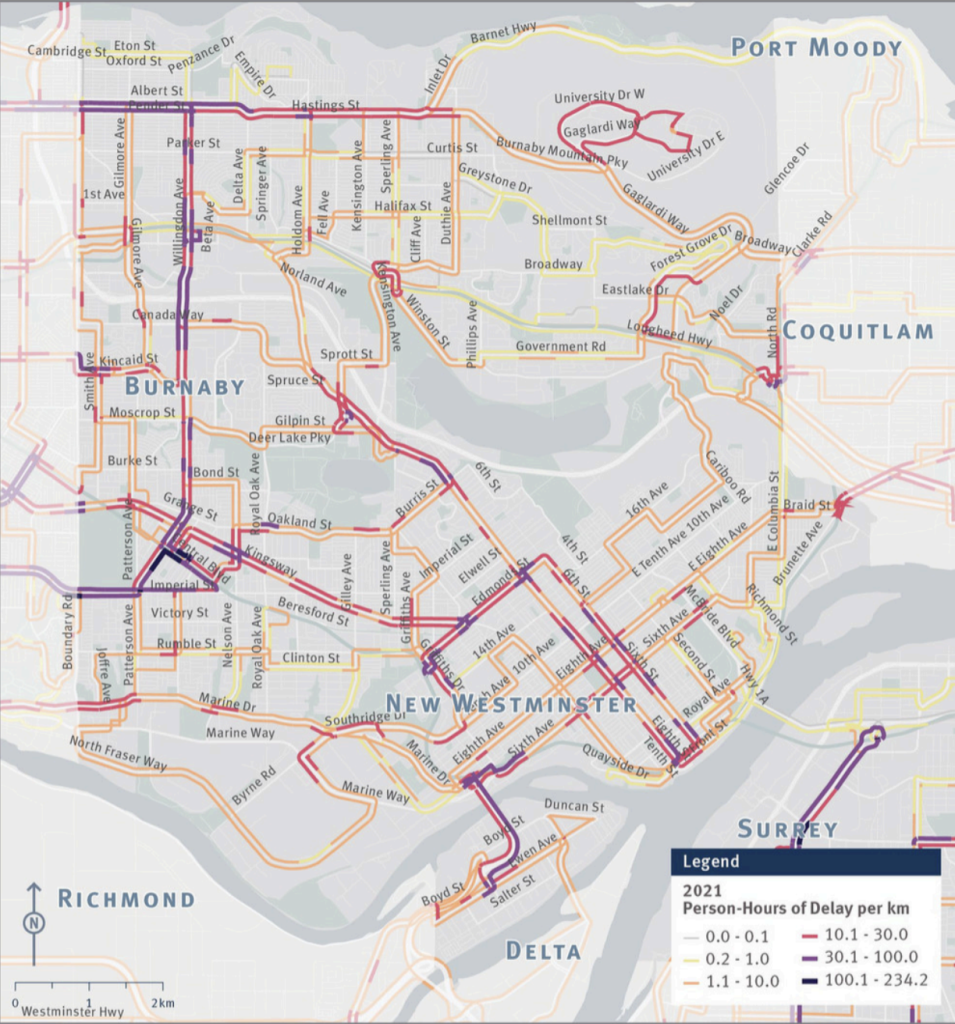
19 November 2024 – On Monday night, Burnaby City Council approved a motion to dedicate curbside bus lanes on Hastings Street between Delta Avenue and Duthie Avenue from 7am to 7pm.
This motion was amended to address concerns about reduced parking from members of the business community.
During the council debate on the motion, several councillors broadly indicated their support for bus lanes that would not impact retail parking. Movement is eager to work with Burnaby council and identify potential bus lane locations that meet that criteria. “In their comments today, council has shown that they’re willing to take action on the growing congestion that is gradually bringing Burnaby to a standstill. Even motorists have told us that they want bus lanes, because they know that we can’t keep pouring more cars onto city streets without giving people a good alternative. Our next step is to ask council to keep going and get buses moving in other parts of the city. Fixing these bus routes will finally give Burnaby residents affordable options for getting around that they can rely on,” said Denis Agar, Movement’s Executive Director.
25,000 transit riders per day will benefit from the bus lanes that council championed today – over 3% of the entire region’s bus users.
This motion was based on the Hastings Street Improvement Plan (HSIP); a joint-effort of the City of Burnaby and TransLink launching in 2021. It aims to improve transit performance on Hastings St and includes the 3.6 km section of bus lane being discussed at council. In 2022, public consultation and engagement was completed and involved:
- 12 stakeholder pre-consultation interviews
- 928 completed online surveys
- 2 stakeholder workshops (one virtual and one in-person)
- 9 stakeholder workshop attendees (representing business, education, active transportation, and police services)
- 4 written submissions via email
These new bus lanes will cost-effectively deliver on several of Burnaby’s key
commitments:
- Burnaby Climate Action Plan: reduce emissions from vehicles by 100% by 2050
- Burnaby Transportation Plan: have ¾ of all trips done by active transportation or public transportation by 2050
These bus lanes will also save TransLink $220,000 in annual operating expenses that they will use to improve service.
Movement will remain engaged in the process to ensure that these new lanes are completed in a timely fashion, and that Burnaby finds a solution on the western portion of the corridor that was removed from this motion with an amendment.
Further west, the segment of Hastings between Boundary and Willingdon remains outside the scope of this motion. It will be part of an extension of TransLink’s R2 RapidBus, and eventually Bus Rapid Transit (BRT), for which funding was confirmed in the BC NDP’s 2024 election platform. This new BRT line will extend from West Vancouver, across the Second Narrows Bridge and through Burnaby Heights to Metrotown. What distinguishes BRT from RapidBus service is a much higher level of transit priority leading to levels of speed and reliability approaching that of SkyTrain, for a fraction of the price. Successful BRT systems can be seen in Ottawa, Indianapolis, Los Angeles, and in dozens of other cities around the world.
Comments from multiple councillors indicated that they would support median bus lanes for that BRT through Burnaby Heights. Their comments were based on the idea that median bus lanes would preserve on-street parking. We are encouraged by these early concepts from council, and we will continue to encourage them to consider offset bus lanes as a low-cost interim measure, until BRT can be completed. Offset bus lanes are located in the second lane from the curb (pictured below).

Most Congested streets for buses in Burnaby (TransLink)